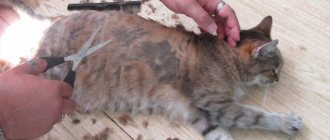Among the owners of mustachioed and striped pets, there is probably not a single one who has not at least once wondered how to remove a cat from a tree. By the way, owners of apartment cats should not think that this problem will not affect them - a domestic purr can easily jump onto a branch right from the balcony if a suitable tree grows nearby.
How to remove a cat from a tree? American police experience
When to remove a cat from a tree
Cats' paws have a special structure that easily allows them to climb almost any vertical surface, including trees. But if a cat can climb up without any problems, then problems often arise with descent to the ground. Animals are simply afraid to climb backwards, and jumping is not always possible.
You can try to persuade the kitten to get off the branch
So how do you understand that a cat has climbed a tree and cannot get down, and what to do in such a situation?
The first sign that a furry one needs help is that it begins to meow pitifully. An animal can sit on one branch for a long time, afraid to move or walk a little where it considers it safe.
Note! If it is cold outside, then you need to start a rescue operation immediately. The cat may freeze, and weakened muscles simply cannot support the weight of his body. In addition, it is worth remembering that the wind is felt stronger at the top, so it is extremely important to lower the animal before it gets frostbite.
If crows are spotted nearby, then you shouldn’t hesitate either. A cat can become an easy target for them, because on a tree he will not be able to repel these bloodthirsty birds, especially if he poses a threat to their nests.
Water condition
The aquarist should always monitor the condition of the water in the aquarium - its general hydrochemistry and especially the oxygen content in it. All indicators of water, including its temperature, must meet the requirements of the organisms in it. At the same time, in order to maintain optimal water parameters, the water in the aquarium must be periodically replaced, either partially or completely, depending on its volume. Also, any aquarium needs a filter.
If you fill the aquarium with water correctly, start it up correctly and control the condition of the water in it, then it will last for many years.
The first launch of an aquarium requires careful preparation. First you need to study the information and purchase the necessary equipment. Before starting, you should already understand what kind of inhabitants will inhabit the aquarium and how much space they need. Based on this, the shape and size of the aquarium is selected, and then all the other equipment:
We wash and check the aquarium.
Place the aquarium in a previously prepared place and secure the background (optional). The background is designed before laying the soil and especially before filling the aquarium with water.
We fill the bottom with soil. If you have plants in your aquarium, the soil should consist of two layers. The first is nutritious, the second is classic, natural color, 2-4 mm in diameter. For example, this is a combination of Tetra Complete Substrate (nutritious) and Tetra Active Substrate (classic).
We install equipment and decorations.
The next step is to install the equipment. Bring the equipment to the aquarium, carefully install the equipment according to the instructions, but do not connect it yet.
When installing an external filter, measure the required length of the hoses through which water will circulate from the aquarium to the filter and back, and cut off the excess to avoid kinks and to save space. An internal filter is usually installed in one of the back corners of the aquarium. If desired, it can be decorated, but in such a way that the water circulation around the filter is not disrupted.
READ Colitis in cats: symptoms and treatment
Place the decorations in such a way that they do not interfere with the view of the aquarium, the operation of the equipment, and do not occupy all the free space. The fish should have enough room to move.
Once the equipment and decorations are installed and the plants are planted, you can fill the aquarium with water. Regular tap water is best for this. First, it needs to be allowed to stand for 3-4 days, in a glass container without a lid.
How to fill an aquarium correctly? Place a shallow plate on the ground and pour water into it so that it slowly flows out of it onto the ground. If you immediately pour water onto the ground, it will wash it away, and your work on decorating the aquarium will go down the drain.
Connect the equipment as soon as you fill the aquarium. Carefully monitor its operation and regularly measure water parameters. At the time of settlement with fish, everything should be in perfect order!
The most interesting thing is ahead - populating the aquarium. We'll talk about how to add fish to an aquarium in our next article.
The splash picture for this article shows a fragment of an ordinary amateur aquarium. Do you want to know how many fish live in it? Then click on this picture. Did you click? Now answer the question: were all these fish placed there at once? I’ll give you a hint – not immediately, but gradually. Therefore, the first month of the life of this aquarium was without pests or fish diseases.
What to do if a cat climbed a tree but can’t get back down
Before rescuing the cat and removing it from the tree, it is necessary to remove foreign objects that could injure the cat if it falls. You can put things or objects that will help soften the blow. Warm blankets, cardboard boxes, etc. are suitable for this.
It's not always possible for a cat to get down from a tree on its own.
Cat bait
You can try to lure the cat, then it will come down from the tree on its own, for this you need:
- If this is your cat, try offering him his favorite dish, and call him in a calm voice. When an animal eats dry food, you should rustle the bag of food loudly. If a strange cat is stuck in a tree, try offering him animal treats: fish, meat, minced meat. Hot foods smell stronger, if possible, reheat your food. Find an opportunity to place food as close as possible to where the cat sits. Leave the second portion under the tree.
- Officials from the Ministry of Emergency Situations (MES) recommend smearing the tree with valerian tincture. But this method only works on 30-35% of cats, and 60% of cats. If a young kitten is sitting on a tree, it is strictly forbidden to use this drug. This will only scare the pet away, and it will climb higher up the tree trunk. Also, valerian should not be used when the animal is sitting on a high tree, the medicine has an “intoxicating” effect and the cat can harm itself.
- Try using a laser beam. If the animal is young and active, move the laser slowly from the animal's location down the tree. If the animal is exhausted, this method will not bring the desired result.
An animal's favorite treats can entice it to come down
- Try calling the cat, your voice should be calm and affectionate. Make sure there are no objects nearby that will scare the cat. Move away from the tree, slowly a short distance and continue calling. Perhaps the pet will follow you and come down from the tree.
- If bait and persuasion do not help, try removing the animal yourself. To do this, use the stairs. Wait a while, the animal will get used to the new object and will not be afraid of it, then climb the tree.
- Do not use unreliable structures - you will harm both yourself and your beloved pet. If the tree is tall, it is better to seek help from special services.
You can call the cat, sometimes animals come down to the voice of their beloved owner. Or go after him yourself
Trying to free your pet from captivity on your own is a completely solvable task. There are a number of tricks that allow you to return your cat to solid ground without contacting special services. Before starting a rescue operation, it is necessary to prepare the area near the tree by removing foreign objects.
This could be remains of construction debris, glass or branches. You can lay disassembled cardboard boxes, old unnecessary clothes, a mattress or a blanket near the tree. If the cat falls down during the rescue process, precautions will prevent possible fractures when hitting the ground.
You can try to persuade the cat to come down on its own. It is advisable that the owner be alone, without strangers or intrusive advisers. You can ask idle onlookers to move away so as not to further disturb the exhausted and exhausted animal. It is also important that there is no free walking of dogs nearby.
The owner's voice should be filled with confidence and calm. You can leave the animal for short periods of time so that it comes into view. The cat is afraid of large crowds of people, loud screams and sounds, as well as flapping of arms. Instead of calmly descending on its own, the cat begins to climb even higher.
One effective way is to play on animal instincts. A cat is a predator by its animal nature, so it is quite easy to make contact if you offer them food.
After spending a certain time in captivity without food or drink, cats become much more sociable. The effectiveness of the method can be increased by using the animal’s favorite delicacies - aromatic fresh minced meat or fish (tuna is best, as it has a characteristic pronounced fishy aroma). It is recommended to heat the food so that the smell reaches the cat's nose faster.
If the tree has a fairly porous trunk, then in this case you can leave a small portion of food on the trunk, and a second portion directly on the ground in front of the tree. After the food has been placed, it is recommended to go a short distance and observe the animal’s reaction.
In addition to food, you can leave a small bowl of water near the tree. Sitting on a tree for a considerable amount of time, cats suffer more not from hunger, but from thirst. It is important to be close to the tree, so that it is in sight, since the bait in the form of food can attract other animals, especially stray dogs.
Some recommend using an infusion of valerian, supposedly it will make the animal come down as quickly as possible. Veterinary experts do not recommend conducting such experiments. The fact is that the infusion of this plant causes an inadequate reaction in cats, causing increased aggressiveness.
An excited and frightened animal under the influence of valerian may try to jump from a very high tree and in this case serious injuries cannot be avoided.
We suggest you read: Is it possible to feed a cat baby food?
You can try to remove the steeplejack from the tree using an extension ladder. The sliding ladder must be placed against the tree trunk so that the descent is gentle. You should not expect that your pet will quickly understand what kind of help has come to him, but give him some time to assess the situation.
Some people recommend using a long-handled broom wrapped in cloth as an aid. The rescuers' recommendations are based on the fact that you need to try to remove the animal without scaring it even more.
Seeing a strange object, the animal may become very frightened and climb even higher than it is. If a cat understands that it is possible to cling to a broom as if it were a life preserver, there is a great risk that the animal will fall and be seriously injured if it falls. You should not try to swing small trees to make the animal jump faster from a dangerous height. Such actions can lead to serious emotional distress.
If the furry pet does not respond to food bait, the pet owner can try to remove the cat using a laser pointer. To do this, it is important that the cat is clearly visible on the branches.
The laser beam must be directed so that it is in the cat's field of vision. As soon as the animal shows interest in the beam, you need to carefully move the stream of light closer to the base of the crown, slowly repeating the attempts again and again.
Note! If the methods described above do not bring the desired result, and the cat remains on the tree for more than a day, it is recommended to contact a specialist.
Many cat owners panic much more than the animals themselves; if the pet has developed some climbing and descent skills, there is no need to panic. Look at how your cat behaves in the tree: he is calm and does not scream, does not worry or get nervous, perhaps he needs to suffer a little.
Your cat (cat), having had enough of its time, may get off on its own a little later. If the skill of conquering peaks in cats has been worked out to the smallest detail, then the descent is accessible to not many; the complex structure of the bones allows cats and female cats to quickly climb up, but to descend they have to back away; not all animals have such skills.
In what cases is it recommended to remove a cat from a tree:
- If you don’t want to wait in vain, there are some conditions and situations in which it is simply necessary to remove a cat, these include:
- If the pet is very worried: constantly meows, rushes about, trembles, and so on.
- If the animal looks weak and tired. Usually this means that the cat is emotionally exhausted, fear and nerves have exhausted the animal, and in the end it will simply fall due to loss of strength.
- If an animal is at altitude for more than a day, it can simply lose strength and fall at any moment.
- If the cat is young and simply does not have the skills to descend, then they can only be saved with someone else's help.
- The weather is bad outside, rain, snow, frost, it is better to remove the animal as soon as possible.
- An animal can climb a tree with various accessories (leash, clothing, harness, etc.), and there is a risk of injury in the branches, possibly even suffocation.
- If the descent is dangerous, it has climbed very high, there are power lines nearby, and so on.
- If you feel that the cat will not get off on its own.
In all of the above situations, it is necessary to release the animal.
Other methods
If you were unable to lure the cat and it is not sitting high, use a ladder. The ladder is attached to the trunk in an inclined position, creating a gentler descent. There is no need to climb up the stairs or wait at the bottom - the cat must get used to the new object and make sure it is safe. Assess whether the cat can climb down the ladder from the tree on its own and step aside.
It is not recommended to remove a cat from a tree using objects such as a broom raised upward, as the animal will either climb higher or cling to an unreliable structure and fall.
Only a person who is confident in his abilities can climb a ladder behind a cat or climb branches. You need to take into account that you need to pull the cat towards you, firmly grasping it by the scruff of the neck (if it sits with its back to you, it should not be pulled along the branch because of the risk of dislocating its paw). During a rescue operation, the animal may cling to you with its claws, so wear long sleeves.
You should not climb a tall tree without special equipment and preparation. You shouldn’t try to climb after your cat in winter because of the risk of slipping. The only effective way in this case is to seek help from rescue services.
How to persuade a cat to come downstairs
How to stop a cat from tearing up furniture: reasons and what you can spray on the sofa
The first thing to start a rescue operation is to try to talk to the stuck animal. It will be better if he hears the voice not of a stranger, but of the owner or one of the family members.
This method does not work often and may be effective when:
- the cat had not been sitting on the tree for very long and had not yet had time to get very excited;
- the furry one is stuck low and just needs support to decide to jump;
- the animal trusts its owner so much that it is ready to take a risk and jump to him from a height.
However, as mentioned above, talking to a cat stuck in a tree is one of the most ineffective methods and rarely helps.
Feeding the steeplejack
Is it necessary to castrate a cat: what will happen if you don’t?
One of the options for getting a cat out of a tree is to bait the steeplejack with a tasty treat. This will work especially well on an animal that has been sitting on a high tree for a long time and has become hungry.
Important! As a bait, you should choose a medium-sized tasty treat so that the cat can definitely see it. An important factor is the smell of the treat; it must be strong so that the stuck animal can feel it even at a decent height.
If the owner knows what delicacy his pet prefers, it is worth using this particular food as bait.
It will be most convenient if the cat is stuck on a branch located near the balconies of residential buildings. Then it will be easier for a person to lure a steeplejack with a tasty treat through a window or vent.
When to save
So, your beloved cat is sitting on a tree. The owner's first instinct is to organize a rescue operation. Is it necessary to do this? Yes, if:
- a pet with a leash or harness, which means there is a risk of getting entangled in the branches and dying from suffocation;
- It’s frosty, hot, or a strong wind is blowing outside. Hypothermia (overheating) is automatically added to the animal’s psychological trauma, which leads to rapid loss of strength. A weakened pet runs the risk of falling and being seriously injured;
- there is a young cat in a tree who has no idea how to return to earth;
Kitten asks for help
- the animal sits in the branches for more than a day and screams;
- the pet is trying to get down and is loudly worried because he is not succeeding;
- the cat, which just recently meowed heart-rendingly, shows no signs of activity. Such an animal is most likely weakened and can easily become a target for crows.
Crow Attack
Rescue measures in such cases are needed urgently, and it is better to remove the cat from the tree before dark.
In other situations, when the cat demonstrates that he sits on the branch voluntarily and feels great, there is no need to panic ahead of time.
I'm exhausted, but I'm holding on
Independent steps to rescue
The owner can try to rescue the animal from the trap on his own. There are numerous ways and tricks you can use to bring your cat back to earth without the help of a professional rescuer.
Before starting the operation to return the pet to the ground, it is necessary to clear the area under the trunk of foreign objects, especially the remains of building materials and hazardous debris. If possible, you should lay unfolded cardboard boxes, old things, mattresses, and blankets on the ground. Such measures will soften the blow if the cat falls or accidentally falls, and will prevent injuries and fractures when falling from a height.
How to persuade a cat to come downstairs
Before taking drastic measures and climbing a tree after a frightened pet, the owner must first try to “persuad” the cat to come down on its own. Under no circumstances should this be done in front of a crowd of onlookers and compassionate advisers. It is necessary to ask people to move as far away as possible and not to disturb the already exhausted animal. You should also ensure that there are no dogs around. When the crowd of onlookers has been neutralized, persuasion should begin.
It is best to call your cat in a calm voice. From time to time you should move away some distance, leaving the animal in sight. Having calmed down, the pet can make attempts to get down from the tree on its own. Often it is a crowd of people, loud screams, waving arms that frighten the cat, and it not only does not try to climb down, but often climbs even higher.
Feeding the steeplejack
Being predators by nature, domestic cats respond well to food offered to them. After sitting in a tree for some time, without food or water, the pet becomes more accommodating and may try to descend to the ground on its own.
For this method to be effective, it is necessary to offer the animal aromatic, preferably his favorite food. If help is provided to a street cat, you can offer fish (tuna has a strong smell) or minced meat. It is better if the food is warm, so the aromas will reach the cat's nose faster.
If the structure of the tree allows, the first small portion of food can be left on a horizontal tree trunk, between the ground and the stuck animal. The second portion of the bait should be placed on the surface of the ground, near the trunk.
After the aromatic complementary food has been placed, you need to move away some distance and wait until the delicious smell reaches the target. A bowl of clean water should be placed along with the food, since animals that have been sitting on a tree for a long time suffer primarily from dehydration. Both water and food should be supervised so as not to attract other relatives and especially dogs.
Under no circumstances should valerian preparations be used for bait. Drops based on this plant have an unpredictable effect on cats, often causing agitation and aggression. An already frightened animal under the influence of valerian may become more restless and climb even higher or try to jump from a great height.
Using a laser pointer
If the steeplejack does not respond to persuasion and the smell of food, the owner should
know how to remove a cat from a tall tree using a laser pointer. To do this, you need to clearly see the animal in the branches.
The pointer beam should be directed into the cat’s field of vision, but in such a way that its movements behind the beam are safe. As soon as the pet becomes interested in the light source, you should move the luminous flux of the pointer closer to the trunk.
There's no need to rush. If the cat is reluctant to follow the beam, you should try again. Slowly but surely the animal will move along the trunk towards the ground.
Other methods
You can help an unsuccessful steeplejack using a ladder. After making sure that the descent will be safe, the extendable ladder should be placed against the tree trunk so that the descent is gentle. You should not hope that the animal will immediately take advantage of the help provided. It is necessary to give the pet time to get used to the new object and evaluate the situation.
The method that uses a broom wrapped in thick fabric is questionable in terms of safety. It should be understood that the animal may become even more frightened and climb higher. If you have a poor grip on a wrapped broom, there is a high risk of falling and injury. A lot of disadvantages of this method cast doubt on the feasibility of its use.
You should not swing the tree, try to knock down the animal with any object, or climb to a height behind it yourself. Such rash actions will lead to injury to the pet or the “rescuer” himself.
When the listed methods have been tried, but have not led to the desired result, the owner seriously begins to think about whether there is a service in the city to remove the cat from the tree.
Despite the fact that the help of specialists in lowering furry steeplejacks to the ground is not free, nevertheless, the health and life of the animal should be put in first place.
To learn about the nuances of removing cats from trees, watch this video:
Where to start a rescue operation?
Freedom-loving cats sometimes deliberately climb higher in order to feel the beauty of freedom. And if the owner tries to attract it with all sorts of baits, the cat, on the contrary, will try to climb even higher. Therefore, you first need to figure out: is your help needed? However, there are some rules under which an animal must be rescued immediately:
- if the animal is on the tree for more than 24 hours. In this case, there is a danger of dehydration;
- in the event that the cat has a collar to which a leash is attached. This situation can pose a risk of suffocation - the leash gets caught on a branch;
- in the case of a cat screaming loudly, clearly calling for help. She is so scared that she definitely won’t be able to get down on her own.
Less outside help
For a faster rescue operation, it is better not to involve many strangers in it. Since, at the sight of a large crowd standing below, the cat may become even more frightened and, out of fear, will not want to go down. To be safe and secure, leave one person to help you.
You can use bait
You can get a cat that has been sitting on a tree for a long time by luring it with food or water. However, you should not hold the bait in your hands and try to demonstrate it to the animal in every possible way, this will cause the opposite effect. Place the food as close to the cat as possible on a branch and move away. A hungry animal will try to get down to her.
A bird or mouse sitting in a cage is also a good bait. The hunting instinct can overcome fear. You can borrow such bait from neighbors or friends. In this case, there will be no harm to the bird or rodent.
Is it possible to drag a cat by the tail?
How to stop a cat from marking territory in an apartment
When the question arises of how to remove a cat from a tree, all available methods are used. It happens that the cat is either stuck low or sitting on a branch growing not far from the balcony or window. Sometimes it happens that a person climbs the stairs to a height where a fluffy one is stuck, but the latter is not given into his hands.
Then you need to remove the victim by force. In general, the cat's tail is quite fragile and plays an important physiological role, but if pulling on it is the only way out of the situation, then you can resort to it.
How emergency services specialists rescue
Unfortunately, there is no service professionally involved in removing animals from trees. Most often, owners and compassionate people turn to the local branch of the Ministry of Emergency Situations. Employees of this department are not obliged to rescue pets, but, as a rule, they meet halfway and provide professional assistance to sufferers on a commercial basis. Having in their arsenal high sliding ladders, special “crampons” for climbing poles, and climbing equipment, emergency service employees can remove a pet even in the most difficult situations.
Fire department removes kitten from tree
Call the rescue team
When the listed methods end in nothing, the last option remains is to contact an organization that would help in this matter.
Rescuers of the Ministry of Emergency Situations are ready for anything
Considering that in Russia there are no narrow-profile structures that would specifically deal with the rescue of poison dart cats, you can call:
- the utility service may have people working there who can remove a pet from a tree;
- to the local rescue service or department of the Ministry of Emergency Situations. By the way, they are not obliged to remove pets from trees, but they often do it, and even for free;
- to a company that deals with cutting down trees and trimming crowns. Alternatively, you can turn to professional climbers. These guys have the equipment and skills to help you deal with the problem quickly.
Don't forget about the possibilities of the Internet. An advertisement posted on social networks sometimes “works” much faster than some services respond to a call.
Table 1. Selected information on the cost of services for removing cats from trees in individual cities of Russia.
| City | Executor | Service cost | Note |
| Novosibirsk | Private person | From 2000 rub. for the challenge | Ready to climb a tree, provided it is strong |
| Kaluga | Private individual with experience in animal rescue service | During the day - 3000 rubles; at night – 4500 rub. | If necessary, I am ready to come with a veterinarian |
| Samara | A company offering professional tree care | From 2000 rub. for the challenge | — |
| Omsk | A company offering industrial climber services | From 2000 rub. for the challenge | — |
| Orenburg | From 1500 rub. for the challenge | — |
Undoubtedly, calling rescuers can be expensive, because often special equipment is involved in the process, and the work of people costs some money. And yet, no matter how much you have to pay to save your beloved cat, his life and health are incomparably more valuable.
Saved!
Using a laser pointer
This method will work best with a young cat or kitten stuck on a tree branch. Growing animals are naturally more playful than their adult relatives. And almost everyone knows the love of cats for the red dot from a laser pointer.
When a cat is removed from a tree, it is not a fact that he will not climb it again
If the steeplejack is sitting in a place where the leaves do not block the view, you can try to lure him down using a laser pointer. You just need to shine the light first on the tree where the cat is sitting. Then, when the animal notices the red dot, slowly move it to the lower branches.
Important! In this situation, the person has the responsible task of choosing the safest route to descend. An enthusiastic cat may forget about caution and inadvertently fall or jump onto an unstable branch. The person must move the pointer so that the cat climbs only along a safe path.
Rescue help
What should you do if your cat is stuck in a tree, you can’t get it off on your own, and she’s afraid to get down? Perhaps you should call the Ministry of Emergency Situations. The rescue service dispatcher will give remote recommendations over the phone on how people should behave before the rescuers arrive.
Don't be afraid to seek help from specialists. They know exactly how to get a cat out of a tree, and will be able to save an animal whose owners’ fear could cost it its life. The owner of a stuck cat should help emergency workers whenever possible. They may need the cat to hear the voice of a familiar person or simply see him. As a rule, cats are more willing to go into the hands of those they know.
Kindhearted Helpers
– I know how to get a cat out of a tree! Let's shake it until it falls off. It's not that high here - you won't get hurt.
- No no. Let's throw our hats at it - we'll knock it down sooner or later.
- What are you, monsters! I brought some cheese, now we’ll lure you in: “Kys-kys!” Look what I have, get off.”
And the cat looks down and thinks: “Yeah, we ran away. I won’t go to them - they yell, wave their arms, look so intently. Oh well, they'll beat me again! Who knows what they want from me..."
To calm an already frightened cat at least a little, ask the crowd to disperse. You can leave one assistant who will provide backup if you have to climb a tree. But the crowd is a stress factor that needs to be eliminated.
1. The first thing to do is eliminate potential intimidating factors. Perhaps the cat was frightened by a dog that continues to walk nearby, a crowd of people, or a firecracker. It is highly likely that the cat will come down from the tree on its own when it realizes that it has nothing to be afraid of.
2. Clear the area around the tree. Of course, it is not necessary to pick up candy wrappers, but it is better to remove glass shards, sharp sticks, stones and other dangerous objects. It is impossible to predict where a cat will land when it jumps. Try to protect her from injury.
3. Soberly assess your strengths. Even if you were the best tree climber as a child, things might have changed now. You may still be in excellent physical shape, but can you guarantee that the tree will support your weight? Be careful and do not take rash actions, otherwise you will have to save not only the cat, but also you!
4. Lure with food. If the cat's initial shock has already passed, try to lure it with a treat. Show him your favorite bag of food or treat. For greater effect, open the package to allow the scent to spread. This method will work if the cat was able to pick itself up. Unfortunately, a truly frightened pet has no time for food.
5. Offer the cat a path. If the cat has not climbed very high, a “ladder” will help correct the situation, i.e. a safe way from above to the ground. You can use a strong wide board or stepladder as a ladder. Just lean it against a tree and give the cat some time.
6. Use a ladder or stepladder. If climbing trees is a bad idea, then a ladder or stepladder is a great option. Just do not forget to enlist support for your safety: a stepladder or ladder must be supported. If safety is assured, carefully climb up and rescue your furry wretch. And don’t forget about the next point (item 7).
7. Wear a long-sleeved sweater or long, thick mittens. Even if your cat is the most affectionate creature in the world, you cannot predict how she will behave in a stressful situation.
8. If unsuccessful, contact a professional. If your attempts do not bring results, and the frightened cat has been sitting on the tree for several hours, it’s time to call the Ministry of Emergency Situations. Rescuers will bring your fugitive home!
These steps will help remove the cat from the tree. But what you definitely shouldn’t do is: shake the tree, throw snowballs, sticks and other objects at the cat, try to scare it away, etc. All this can lead to unexpected and very unpleasant consequences. Be careful and careful!
Preparation
It is easy to remove the cat if it has not risen too high and is at arm's length. But if the pet is on top, you need to remove it carefully and carefully. To do this you will need:
- Look around carefully. Perhaps there is a dog near the tree, the cat is afraid and does not get down.
- Find out the reason for the cat’s reluctance to go down; perhaps it is worried about the crowd of people below. The crowd must be asked to disperse.
- Clear the area under the tree, spread blankets or cardboard under it.
- The owner should put on thick clothing, since a frightened cat may behave inappropriately and begin to scratch its savior.
- Talk to your pet calmly so that he calms down, after which you can begin active actions.











